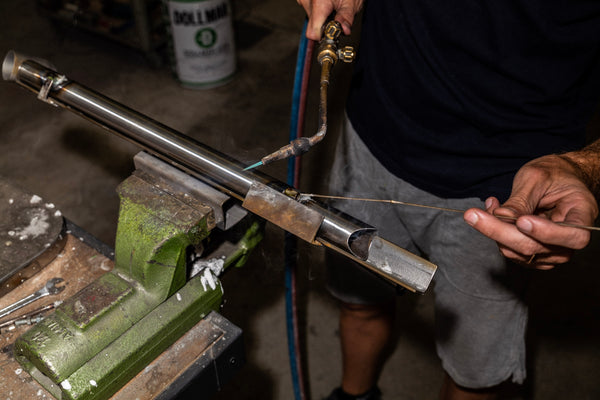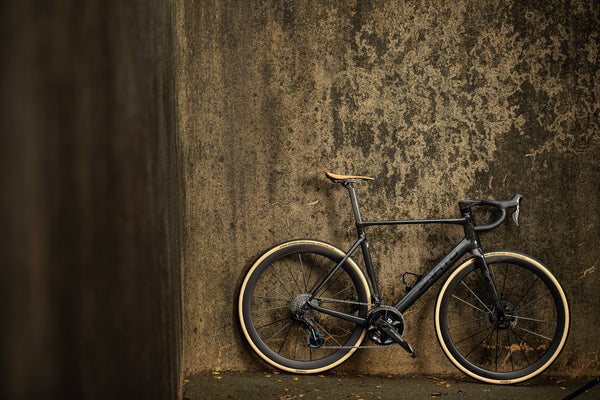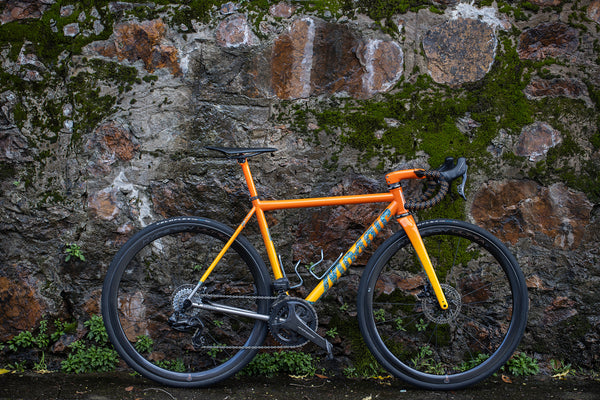Option paralysis. It’s something that plagues nearly all aspects of our obsession with bicycles, and it’s oh so apparent when trying to select the perfect tire for your gravel bike. The right set of tires can be the difference in feeling confident or sketched out on a new technical line. They can be the difference between feeling super fast or painfully sluggish on your way to a new fire road PR. Big knobs, small knobs...slicks? Seriously, the options are endless, and trying to sort out which tires are right for you can be a majorly daunting task. Today we’ll do our best to give some guidance on all of the variables to help you hone in on what kind of tire will suit your riding best.

We’ll make one blanket statement here at the beginning: if you’re doing any off-road riding, do yourself a favor and stick to tubeless. Doing away with conventional inner tubes greatly minimizes potential for flat tires, and allows you to ride at lower pressures which is critical for performance in the dirt. So if you’re not already riding tubeless, just do it. With that out of the way, let’s dig into the guide.
Choosing the Diameter
If you’ve been around any circles of gravel riders, then surely you’ve heard people talking about 700c or 650b. We actually did an article on this specifically a while bike, which you can check out here, so we won’t get too deep into now, but the gist is that 650b (aka 27.5) allows your to run a tire with a higher volume and taller profile, while having a similar overall tire diameter to a more traditional 700c counterpart. We’ll delve deeper into tire volume in the next section, but basically what you need to know is with 650b you’re getting a wider contact patch and more air between your rim and the ground, which can equate to more traction and a more forgiving ride when the tracks get rough.
Now, also keep in mind that the extra rubber is going to weigh more and have more rolling resistance. It will also have an effect on your bike’s handling characteristics, which could be a good or bad thing. Your size and bike height will factor here as well, as 650b can be a more appropriate fit for smaller riders.

So how do you know what’s right? Generally speaking, if top speed and efficiency are a priority then you might consider 700c. If you’re doing a lot of rough technical riding or ride a smaller size bike, then 650b could be your ticket. It’s actually quite common that we set up our riders with two different wheelsets so they can swap accordingly depending on where they plan to ride that day.
Choosing the Volume
So how big of a tire do you need? These days we see gravel tire volumes in incremental sizes anywhere from 30c all through 50c and up, even wider if you opt for 650b. That’s a lot of options! Picking out the right size can be quite the dilemma. The higher the volume, the bigger contact patch you’ll have, leading to more control and traction. Also with higher volume, you’ll effectively have more suspension, which again helps with traction and control, but also helps to minimize fatigue on the rider. In essence, increasing the tire size increases your bike’s capability. So you might be thinking, go as big as I can right? While that’s not necessarily a bad philosophy, it’s not entirely that simple.

An obvious consideration is that a bigger tire is going to be heavier. Remember, tires are rotational weight, which means it will have one of the more perceivable impacts on both ride feel and acceleration. Something less obvious is the effective rebound rate of the tire. As you increase the volume of the tire, the tire will rebound faster at a given tire pressure, resulting in a bouncier feel. To combat that, you’ll want to run lower pressure. You’ll gain smoothness and traction, but at the cost of the bike feeling more sluggish.
Picking what’s right for you is really a subjective thing, but we’ll give some basic guidelines.
Are you riding a fairly even split between pavement and dirt, or prefer to stick to the smoother groomed trails? Something in the 30-36c range on a 700c rim will probably suit you pretty well.

Are you riding mostly dirt and want a tire that will still roll relatively fast on the smooth sections, but still keep you covered when venturing onto single track or torn up sections? A tire in the 35-40c for 700c or 42-48c on 650b would make a good choice.

Do you treat your gravel bike like a mountain bike and like to push the limits of what’s rideable? Or maybe like to go bikepacking and load your bike up with tons of gear for extended trips into the backcountry? Then a 40-50 700c tire or a 2.0-2.4” 650b tire is probably what you're after.

Now obviously, you’ll be limited by what your wheels and frame size allow and you’ll also want to consider your size and weight, but this should provide a pretty useful baseline.
Choosing the Casing
The next thing to consider is the casing. Honestly, this can be a tough call. Tires with a lightweight, more supple casing will undoubtedly offer a more premium ride feel. There’s really no comparison to the buttery smooth ride quality of a light casing tire. That said, durability is real concern when you’re out in uncharted terrain. Nothing will ruin your day like a big sidewall gash. For many, a heavy duty casing is worth the weight penalty for peace of mind.
Most brands offer tires in a range of casing options. René Herse offers each of their models in, Extraligtht, Standard, Endurance, and Endurance Plus. Vittoria gravel tires only come in one casing, and it has proven to be incredibly tough. Challenge gravel is impressively light and smooth, but has been more prone to punctures.

How do you choose? If you’re a weight weenie wanting the smoothest ride possible, and are okay with approaching technical sections with caution to avoid punctures, then go with a light casing. If you want the most worry free set up and don’t mind the weight or suppleness penalty, then a heavy casing is the way to go. For most riders though, a standard casing tire works out pretty well.
Choosing the Tread
Here’s what most people find as the exciting part, seeking the perfect tread. There are dozens of options out there, and they're all going to behave a bit differently. We'll break it down here into a few general categories.
Slick(ish)

To some this may come as a surprise, but sometimes there isn’t a need at all for any extra tread. Depending on where and how you ride, a little bit of extra volume and a little more durability is all you need. With a little bit of bike handling know-how and a little bit of extra volume, you’d be surprised how capable a slick tire can be, especially when dropped to a lower pressure. Now don’t expect any miracles if you try to charge into a washed out fire road corner at high speed. And if you’re trying to make it up a steep technical climb, you’ll definitely need to put in work managing your weight distribution to keep the tires from spinning out. If you’re going for gold in the downhill segments of Grinduro, you may want to look elsewhere, but if you tend to ride primarily on pavement but want the freedom to venture into the dirt at will (AKA all-road), a high volume slick can be the perfect answer.

Some of our favorite options here include the Chinook Pass from René Herse, the Gravel King slick from Panaracer, and the G-One Speed from Schwalbe.

Semi slick
The tell tale sign of a semi-slick is a low profile centerline with a pronounced side knob. The goal of these style tires is to maintain speed and efficiency while rolling in a straight line, but still have support and security when leaning into dirt corners. Sounds like the perfect combination, right? For many riders, a semi-slick is the perfect style, but they do have some drawbacks worth considering. While a slick centline is fast on the road and straightways, it won’t provide the braking or climbing traction of a more thoroughly treaded tire. Another consideration is that while the pronounced corner knobs can work wonders hooking up in dirt corners, the transition can feel abrupt and unnerving when leaning into turns on pavement. If you can live with those compromises, a semi-slick can be a winning option, especially for the racer prioritizing rolling speed.

Some proven options here are the Vittoria Terreno Dry, WTB Riddler, and Schwalbe Thunder Burt.

Mild knob
This is the sweet spot for most riders and where we generally recommend people to start. What you’re looking for here is a consistent profile and knob spacing across the tire, usually slightly tighter down the centerline for increased speed. These kinds of tires provide a consistent feel and handling across the widest range of surfaces and conditions. Compared to the slick or semi-slick, a tire with slightly more pronounced tread down the center will help provide significantly better braking control and climbing traction. These style tires typically have a rounder overall shape compared to a semi-slick, and while they might be a bit slower on the pavement, they’ll have a much more consistent cornering feel across varying terrains.

This segment is where you’re likely to find the most options. Some of our favorites include the René Herse Steilacoom Pass, WTB Nano and Resolute, Schwalbe G-One All-Round, Ultradynamico Rosé, and Vittoria Terreno Mix.

Chunky Knob
There’s a contingent of riders who enjoy a tire that looks more appropriate for an enduro MTB rather than a rigid drop bar bike. If you’re seeking the steepest and loosest terrain, or ride in harsher conditions, a chunky knob might be what you’re after. You’ll definitely be giving up speed and efficiency, especially on the road, but you’ll gain loads in confidence and control as the terrain gets more demanding. Do you like to “send it” any chance you get? This might be the option for you. Are you still building up your off road skills and want a tire that can help keep you safe when things get over your head? Then a heavily treaded tire might be the optimal choice for you too.

Some notable options here include the WTB Sendero, Schwalbe Rock Razor, and Maxxis Ravager.

So what kind of tire best suits you? Hopefully this has helped you identify the tire traits that will work out best for you. Got a favorite model or size? We want to hear from you, so let us know down in the comments so we can keep a discussion alive.
If you're in need of some fresh rubber, you can check out our current offerings here. Don't see what you're looking for? Send us a note, we might have them hiding somewhere in the shop and if not, can get nearly anything on special order.






Back to Journal